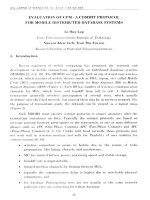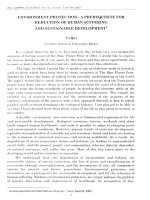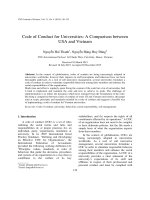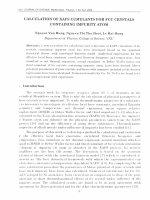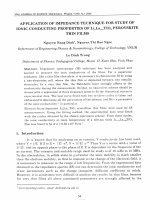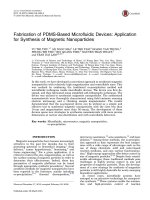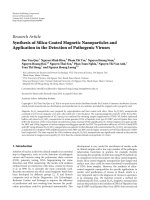DSpace at VNU: Application of gold nanoparticles for early detection of breast cancer cells
Bạn đang xem bản rút gọn của tài liệu. Xem và tải ngay bản đầy đủ của tài liệu tại đây (2.27 MB, 4 trang )
e-Journal of Surface Science and Nanotechnology
27 December 2011
Conference - IWAMN2009 -
e-J. Surf. Sci. Nanotech. Vol. 9 (2011) 544-547
Application of Gold Nanoparticles for Early Detection of Breast Cancer Cells∗
Luu Manh Quynh, Tran Quoc Tuan, Nguyen Hoang Luong,† Nguyen Ngoc Long, and Nguyen Hoang Hai
Center for Materials Science, Faculty of Physics,
Hanoi University of Science, 334 Nguyen Trai, Thanh Xuan, Hanoi, Vietnam
Tran Thi Thanh Thoa, Nguyen Thi Van Anh, and Phan Tuan Nghia
Key Laboratory of Enzyme and Protein Technology,
Hanoi University of Science, 334 Nguyen Trai, Thanh Xuan, Hanoi, Vietnam
(Received 10 December 2009; Accepted 26 September 2010; Published 27 December 2011)
Gold nanoparticles (GNPs) have been synthesized by a chemical reduction method using sodium borohydride and
functionalized with amino groups on their surface. The GNPs were then conjugated with the anti-HER2 human antibody (trastuzumab) for detecting breast cancer cells. The specific binding of trastuzumab-conjugated GNPs onto
the breast cancer cells (KPL4 line) were observed by bright-field and dark-field microscopy and were for the first time
observed by scanning electron microscopy and energy dispersive X-ray scanning. [DOI: 10.1380/ejssnt.2011.544]
Keywords: Gold nanoparticles; Trastuzumab; HER2; Breast cancer cells
I.
INTRODUCTION
Nanoparticles have been studied and developed rapidly
for application in diagnosis and treatment, because of
their large surface area and unique optical properties.
At the size ranging from 30 nm to 60 nm, the absorption peak of gold nanoparticles (GNPs) changes from
524 nm to 560 nm [1, 2]; and the light scattering shows
more intense in organic dyes [3, 4]. Optical properties
of GNPs change depending on the diffraction factor of
the surrounding solutions, and on their surface’s electronic properties [1]. In different synthesis methods, the
surfactants such as cetyltrimethyl ammonium bromide
(CTAB), citrate, AuCl4 could link with the GNPs by noncovalent bonds, which make moderate changes on absorption peaks [5]; while the other groups such as ethiol (–SH)
make more visible changes [6]. To apply GNPs in biology, most methods use the so-called bifuntional ethiol–R–
amino group, in which –SH group could contact rapidly
with GNps surface, while –NH2 group remains free and
exposes out side the surface for further conjugation with
other chemical groups of biomolecules [7]. GNPs are potential candidates for cell imaging and cell-target drug
delivery [2, 8–11], cancer diagnostics and therapeutic applications [12–14]. Nowadays, a number of bio-markers
which are expressed at a high level on the surface of
breast cancer has been reported, for example HER receptors belonging to a member of the epidermal growth factor
(EGF) family of tyrosine kinase receptors. These include
HER1, HER2, HER3, and HER4. While HER1, HER3,
and HER4 are overexpressed in various types of cancer
cells, such as head, neck, brain, stomach, breast, colon,
gast, prostate, and so on, HER2 is a biomarker which is
more specific for breast and ovarian [15, 16]. HER2 is
super-expressed with several hundred folds higher in cancer cells of 20-30% breast cancer patients than in normal
cells.
∗ This
paper was presented at the International Workshop on Advanced Materials and Nanotechnology 2009 (IWAMN2009), Hanoi
University of Science, VNU, Hanoi, Vietnam, 24-25 November, 2009.
† Corresponding author:
FIG. 1: Syntheisis of GNPs using NaBH4 reduction and functionalizing them with 4-ATP.
Therefore, HER2 is an interesting target for therapy of breast cancer. Anti-HER2 with generic name
Trastuzumab or trade name Herceptin is a humanized
monoclonal antibody (mAb), which has been approved
by the FDA since 1998 for treatment of metastatic breast
cancer [12, 13, 17]. In this study, we conjugated the GNPs
with anti-HER2 antibody (Trastuzumab) through either
non-covalent or covalent linkages. The Trastuzumabconjugated GNPs were then used to specifically label
breast cancer cells, KPL4 line, for imaging of the cells.
This primary result is fundamental for further application in breast cancer tumor imaging.
II.
EXPERIMENTAL
A. Synthesis of GNPs by NaBH4 and
functionalizing with 4-ATP (C6 H7 NS)
5 ml of 0.01 M NaBH4 (MERCK) at 0◦ C was added to
25 ml of 1 mM HAuCl4 (MERCK) in 50 ml ask with stirring for 15 min, until the color of the solution changed
from lightly yellow to dark red (see Fig. 1). After 2
c 2011 The Surface Science Society of Japan ( />ISSN 1348-0391 ⃝
544
e-Journal of Surface Science and Nanotechnology
Volume 9 (2011)
days, these GNPs were functionalized with 4-ATP. Different volumes of 2 mM 4-ATP were added into 20 ml of
the GNPs containing solution. The color of the solutions
changed from dark red to dark blue, and the solution was
then incubated for at least 1 day.
B.
Conjugation of Trastuzumab to GNPs
Trastuzumab (Dakko Co.) was non-covalently conjugated to colloidal GNPs [2], which were prepared by
NaBH4 reduction (named as NaBH4 *GNPs). The colloidal gold suspension was adjusted by 0.1 M NaOH to pH
6.5 to react with a mixture of non-labeled Trastuzumab
and FITC-Trastuzumab (480 nm/520 nm) at mole ratio
10:1 of final concentration 6 µg/ml at room temperature
(RT) for 5 min. The Trastuzumab-NaBH4 *GNPs were
collected by centrifugation at 4◦ C, at the rate of 30,000
rpm, for 30 min. The pellets were washed twice and then
resuspended in phosphate buffer solution (PBS) with pH
7.4 containing 0.2% bovine serum albumin (BSA).
Trastuzumab was covalently linked to 4-ATP functionalized GNPs (amino-GNPs) through 1-Ethyl-3-(3dimethylaminopropyl)carbodiimide (EDC) connection,
similarly described for magnetic nanoparticles [18].
Briefly, the above prepared amino-GNPs was reacted with
0.2 mM EDC in MOPS buffer with pH 6.0, for 20 min at
RT. Then, the EDC*GNPs were reacted with 6 µg/ml
non-labeled Trastuzumab and FITC-Trastuzumab (480
nm/520 nm) at mole ratio 10:1, for 30 min at RT. The
Trastuzumab-EDC*GNPs were washed three times by
centrifugation at the rate of 13,000 rpm, at 4◦ C, for 13 min
with PBS and then was stocked in PBS with pH 7.4 containing 0.2% BSA. The absorbance profile of the covalent
Trastuzumab-EDC*GNPs was measured and compared
with that of GNPs using Spectrophotometer (Nanodrop).
C.
Culture of KPL4 and Hela cells
KPL4 and Hela cells were cultured in 24-well
ELISA plates containing DMEM (Diffico Modified Eagle
Medium, Gibco Co.) plus 10% FBS (Fetal Bovine Serum,
Gibco Co.). Glass coverslips were added in each well and
the cells were incubated at 37◦ C, 5% CO2 to reach a population of about 4×105 to 106 cells/ml. The coverslips
were then picked out and put into another 24-well ELISA
plate for further immuno-nanogold incubation.
D.
FIG. 2: Schematic diagram of incubation of GNPs with KPL4
and Hela cells.
FIG. 3: TEM images of NaBH4 reduced (A) and of 4-ATP
functionalized GNPs (B); UV-vis spectra of GNPs before and
after 4-ATP functionalizing (C) and of GNPs before and after
conjugation with Trastuzumab (D).
The FITC-GNPs containing coverslips were observed
under AxioPlan epifluorescent microscope (Carl Zeiss),
while the non-fluorescent GNPs containing coverslips were
observed under light microscope with either bright- or
dark-field phases. Next, the scanning electron microscope
(SEM) and energy dispersive X-ray spectroscopic (EDS)
scanning of KPL4 cells were used for detecting the GNPs
distributed positions.
Incubation of Trastuzumab-conjugated GNPs
with KPL4, Hela cells
Coverslips containing KPL4 cells were washed 3 times
with 500 µl PBS before being fixed by 3% paraformaldehyde at RT, for 15 min and then treated with 5% Triton
X-100 at RT for 5 min. After being blocked with 500 µl
of 2% BSA, the coverslips were incubated with 200 µl
either of Trastuzumab-NaBH4 *GNPs and TrastuzumabEDC*GNPs containing solution at a concentration of
3 µg/ml at RT, for 60 min. Schematic diagram of incubation of GNPs with KPL4 and Hela cells is shown in
Fig. 2.
III.
A.
RESULTS AND DISCUSSION
Red-shift of GNPs UV-vis spectra after
functionalizing and conjugation
Due to the change of the surfactant, the so-called surface plasmon resonance (SPR) band of the nanoparticles
changes, and it could be observed through the change
of their UV-vis spectra [18, 19]. Higher dielectric factor
(ε) of the surrounding surfactant makes the peak of the
UV-vis spectra red-shift. Figure 3 shows the transmission
electron microscope (TEM) image of GNPs before (pallet
(J-Stage: />
545
Quynh, et al.
Volume 9 (2011)
FIG. 4: Fluorescence image of FITC-Trastuzumab conjugate
with NaBH4 reduced (E serial) and 4-ATP functionalized (F
serial) GNPs after 5 min incubation with Hela (2 serial) and
KPL4 (1 serial) cell lines.
A) and after (pallet B) functionalizing with 4-ATP. After functionalizing, the peak of UV-vis spectra red-shifted
from 530 nm to 544 nm (pallet C). After conjugating with
HER2, that peak red-shifted once more, from 544 nm to
555 nm (pallet D). These results agree with recent publications [1, 2, 4, 19].
B.
Specific binding of HER2 and Trastuzumab
The specific interaction between Trastuzumab and
HER2 directs the Trastuzumab molecules to concentrate
onto the surfaces of the KPL4 breast cancer cells, where
HER2 molecules are overexpressed and uniformly distributed. Figure 4 shows significant bright signals of FITC
labeled Trastuzumab on the membranes of KPL4 cells,
indicating the specific binding of Trastuzumab on HER2
overexpressed on the membranes of KPL4 cells. The fluorescent intensity of KPL4 cells incubated with FITCTrastuzumab was about 10 times higher than that of Hela
cells incubated with FITC-Trastuzumab, confirming specific interaction of Trastuzumab toward HER2 of KPL4
where the level of HER2 expression is much higher. This
result also shows good purity of Trastuzumab, which is
important for next experiments.
C.
Light scattering of GNPs incubated breast
cancer cells
In Fig. 5, the dark-field images (Pallet H2 and K2)
showed distribution of GNPs on cell surfaces through their
scattering light. When the GNPs were linked with the
Trastuzumab, they bound onto the surfaces of KPL4 cells,
546
FIG. 5: Bright-field (1 serial) and dark-field (2 serial) spectroscope images of non-labeled GNPs incubated with KPL4
(G serial), of Trastuzumab conjugated GNPs incubated with
KPL4 (H serial) and of Trastuzumab conjugated 4-ATP-GNPs
incubated with KPL4 (K serial).
where HER2 proteins are overexpressed. The concentration of GNPs-Trastuzumab nanoparticles on cell membranes created light scattering, reflecting the shape of the
cells. When the GNPs were not linked with Trastuzumab,
dark-field image showed no signal of GNPs (Pallet G2),
indicating GNPs did not bind non-specifically onto KPL4
and that binding of GNPs-Trastuzumab onto KPL4 was
due to specific interaction between Trastuzumab and
membrane protein of KPL4.
The bright-field images showed the morphology of the
cells, confirming co-localization of GNPs bound exactly
onto the cells. As seen in Fig. 5, pallet H2 and G2
showed the light scattering in both cases, of NaBH4 reduced GNPs and of 4-ATP functionalized GNPs, respectively. Thus, using both conjugations of Trastuzumab
with fluorescent dye FITC and with GNPs, dual data of
fluorescent images and dark-field images of KPL4 labeled
with FITC and GNPs certain that Trastuzumab were successfully conjugated with GNPs and that TrastuzumabGNPs could be used for specific labeling KPL4.
(J-Stage: />
e-Journal of Surface Science and Nanotechnology
Volume 9 (2011)
NaBH4 reduced GNPs. The concentrated places of the
GNPs imaged mirrored the location of the HER2 proteins which shows that these proteins de-located and redistributed after 1 day incubation with GNPs.
IV.
FIG. 6: SEM image and EDS scanning image of Trastuzumabconjugated GNPs incubated with KPL4. The scale bars in all
the images are 20 µm.
D.
CONCLUSION
In this work, we are successful in synthesizing GNPs in
solution and functionalizing them with 4-ATP to have
free amino (–NH2 ) groups. The GNPs then were applied for imaging KPL4 breast cancer cells after conjugating them with Trastuzumab. High resolution images of
GNPs-Trastuzumab incubated KPL4 cells were observed
by EDS scanning, and showed where the GNPs were concentrated, which could help study the time dependent mobility of HER2 on the surface of cells.
SEM image and EDS scanning of GNPs
incubated breast cancer cells
Acknowledgments
In higher magnification, SEM and EDS scanning pattern of the GNPs incubated KPL4 cells were obtained.
While the detector scanned on the surface of the sample,
the energy dispersive X-rays of only gold element were
collected. Figure 6 shows the SEM image and EDS scanning image of the KPL4 cells after 1 day incubation with
[1] P. K. Jain, K. S. Lee, I. H. El-Sayed,and M. El-Sayed, J.
Phys. Chem. B 110, 7238 (2006).
[2] K. Sokolov, M. Follen, J. Aaron, I. Pavlova, A. Malpica,
R. Lotan, R. Lotan, and R. Richards-Kortum, Cancer
Res. 63, 1999 (2003).
[3] J. Yguerabide and E. E. Yguerabide, Anal. Biochem. 262,
137 (1998).
[4] Solokov et al., Optical Society of American Vol. 15, No.
11, 6584 (2007).
[5] N. L. Nguyen, et al., J. Phys.: Conf. Ser. 187, 012026
(2009).
[6] F. Zhang, M. W. A. Skoda, R. M. J. Jacobs, D. G.
Dressen, R. A. Martin, C. M. Martin, G. F. Clark, T.
Lamkemeyer, and F. Schreiber, J. Phys. Chem. C 113,
4839 (2009).
[7] D. Miyamoto, M. Oishi, K. Kojima, K. Yoshimoto, and
Y. Nagasaki. Langmuir 24, 5010 (2008).
[8] J. L. West, N. J. Halas, Annu. ReV. Biomed. Eng. 5, 285
(2003).
[9] G. F. Paciotti, L. Myer, D. Weinreich, D. Goia, N. Pavel,
R. E. McLaughlin, and L. Tamarkin, Drug DeliVery 11,
169 (2004).
[10] K. K. Jain, Technol. Cancer Res. Treat. 4, 407 (2005).
The authors would like to thank Ministry of Science and
Technology of Vietnam (Contract No 38/355/2008/HDNDT for Task of Protocol with Israel) and Vietnam National University, Hanoi (Key Project QGTD.08.05) for
financial support.
[11] M. Okamura, T. Kondo, and K. Uosaki, J. Phys. Chem.
109, 9897 (2005).
[12] A. Cirstoiu-Hapca, L. Bossy-Nobs, F. Buchegger, R.
Gurny, and F. Delie, Inter. J. Pharmaceut. 331, 190
(2007).
[13] M. V. Yezhelyev, X. Gao, Y. Xing, A. Al-Hajj, S. Nie, and
R. M. O’Regan, Lancet Oncol. 7, 657, Review (2006).
[14] M. Ferrari, Nat. Rev. Cancer 5, 160 (2005).
[15] P. M. Harari, S. M. Huang, R. Herbst, and H. Quon,
in Head and Neck Cancer: a Multidisciplinary Approach
(Lippincott, Williams and Wilkins, Philadelphia, U.S.A.,
2003), p. 1001.
[16] />herpathway.jsp.
[17] T. N. Khuat , V. A. T. Nguyen , T. N. Phan , V. T.Can,
H. H. Nguyen, and C. Nguyen, J. Kor. Phys. Soc. 7 53,
3832 (2008).
[18] C. F. Bohren and D. R. Huffman, Absorption and Scattering of Light by Small Particles (Wiley, New York,1983).
[19] S. Link and M. A. El-Sayed, Int. Rev. Phys. Chem. 19,
409 (2000).
(J-Stage: />
547
